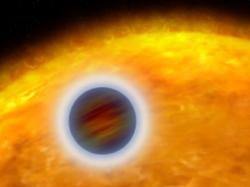 Now here’s a feat. The Hubble Space Telescope was able to analyze the atmosphere of a gas giant planet orbiting another star.
Now here’s a feat. The Hubble Space Telescope was able to analyze the atmosphere of a gas giant planet orbiting another star.
Continue reading “Hubble Sees An Extrasolar Planet’s Atmosphere”
Planets Born to a Dying Star
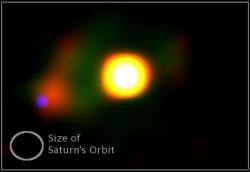 Young stars and new planets go hand-in-hand. But that might not always be the case. An international team of astronomers have discovered a situation where material shed from a dying star is being captured into a planetary disk around a binary companion.
Young stars and new planets go hand-in-hand. But that might not always be the case. An international team of astronomers have discovered a situation where material shed from a dying star is being captured into a planetary disk around a binary companion.
Continue reading “Planets Born to a Dying Star”
Blizzard of Snowflake Particles Around a Young Star
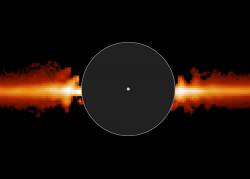 The Hubble Space Telescope has imaged a ring of dust around a nearby star that will probably become a system of planets. The star is AU Microscopii, and it’s located about 32 light-years away in the southern constellation of Microscopium (the Microscope). The particles are probably as fluffy as snowflakes, and about 10 times larger than typical interstellar dust grains.
The Hubble Space Telescope has imaged a ring of dust around a nearby star that will probably become a system of planets. The star is AU Microscopii, and it’s located about 32 light-years away in the southern constellation of Microscopium (the Microscope). The particles are probably as fluffy as snowflakes, and about 10 times larger than typical interstellar dust grains.
Continue reading “Blizzard of Snowflake Particles Around a Young Star”
On Some Planets, the Winds Go Supersonic
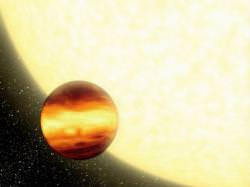 Think of the strongest wind you’ve ever experienced. No, think of the strongest wind anyone’s ever experienced. It still doesn’t hold a candle to the terrifyingly strong winds on some extrasolar planets. There are gas giants out there, with masses similar to Jupiter, that experience winds as strong as 14,400 kph (9,000 mph).
Think of the strongest wind you’ve ever experienced. No, think of the strongest wind anyone’s ever experienced. It still doesn’t hold a candle to the terrifyingly strong winds on some extrasolar planets. There are gas giants out there, with masses similar to Jupiter, that experience winds as strong as 14,400 kph (9,000 mph).
Continue reading “On Some Planets, the Winds Go Supersonic”
Gas Giants Turn Up Early After Star Formation
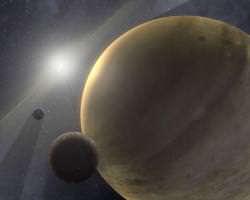 New research indicates that gas giants, like Jupiter and Saturn, form quickly after their stars do. In fact, they probably form within the first 10 million years of a star’s life, or else they never form at all.
New research indicates that gas giants, like Jupiter and Saturn, form quickly after their stars do. In fact, they probably form within the first 10 million years of a star’s life, or else they never form at all.
Continue reading “Gas Giants Turn Up Early After Star Formation”
New Planet Hunter Prepares for Launch
A powerful new instrument for finding extrasolar planets is about to launch: COROT (Convection Rotation and planetary Transits). Developed by the European Space Agency, COROT will search for planets using the transit method; it will be able to detect the slight drop in brightness as a planet moves in front of its parent star. If the observatory performs as expected, it should be able to detect rocky worlds just a few times larger than the Earth. COROT is scheduled to launch in December, 2006.
Continue reading “New Planet Hunter Prepares for Launch”
Brown Dwarf Companion Seen Directly
Astronomers have directly imaged a brown dwarf companion to the star HD 3651. This star is already known to host an extrasolar planet – less massive than Saturn, but sitting within the orbit of Mercury. HD 3651 is slightly less massive than the Sun, and is located 36 light-years away in the constellation Pisces. The brown dwarf, or HD 3651B, is probably between 20 and 60 Jovian masses, and has a temperature between 500 and 600 degrees Celsius.
Continue reading “Brown Dwarf Companion Seen Directly”
Day and Night on an Extrasolar Planet
NASA’s Spitzer Space Telescope has measured the day and night time temperatures of an extrasolar planet. This planet is located 40 light-years away, circling the star Upsilon Andromedae. It’s classified as a “hot Jupiter”, and orbits its parent star once every 4.6 days. The temperature difference between the day and night sides is enormous – differing about about 1,400 degrees Celsius (2,550 degrees Fahrenheit). Although the planet itself is tidally locked to the star, and always presents one face, its atmosphere probably does swirl around, and distributes the heat somewhat.
Continue reading “Day and Night on an Extrasolar Planet”
Super Earths Emerge From Snowy Conditions
Many extrasolar planets have been discovered circling other stars, a few of which are 5-15 times the mass of the Earth, and thought to be solid like our planet. Astronomers were surprised to find these planets orbiting small, cooler red dwarf stars. Researchers believe these “super Earths” form in the chilly halo of snow, ice and frozen gasses that collect around red stars as they cool. There probably isn’t enough solid material to form rocky planets much larger than Mercury in the star’s habitable zone.
Continue reading “Super Earths Emerge From Snowy Conditions”
Hubble Examines the Closest Known Extrasolar Planet
The Hubble Space Telescope turned its gaze towards a relatively nearby Jupiter-sized world recently. The planet orbits the Sun-like star Epsilon Eridani, which is located only 10.5 light-years away. This makes the planet so close that it could be directly observable by Hubble, and large ground-based observatories. The best opportunity will come in 2007, when the planet makes its closest approach to its parent star, and the reflected light should make it observable with our best instruments.
Continue reading “Hubble Examines the Closest Known Extrasolar Planet”
